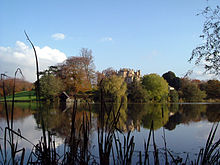Sherborne Castle

Sherborne Castle (sometimes called Sherborne New Castle) is a 16th-century Tudor mansion southeast of Sherborne in Dorset, England, within the parish of Castleton. Originally built by Sir Walter Raleigh as Sherborne Lodge, and extended in the 1620s, it stands in a 1,200-acre (490 ha) park which formed a small part of the 15,000-acre (61 km2) Digby estate. Within the grounds lie the ruins of the 12th-century Sherborne Old Castle, now in the care of English Heritage.
Origins
The building now known as Sherborne Old Castle (50°56′58″N 2°30′09″W / 50.9494°N 2.5024°W) was constructed in the 12th century as the fortified palace of
16th century

After passing through Sherborne on the way to
17th century
During Raleigh's imprisonment in the
18th to 20th centuries

Through the early and mid-18th century
In the
Listings
Both the mansion and the ruins of the old castle were designated as Grade I listed in 1951.[9][10] Three outbuildings of the mansion, built in ashlar and stone, are Grade II* listed: the stables (1759, extended early 19th century);[11] the greenhouse (c. 1779);[12] and the dairy (late 18th century).[13]
The gardens are Grade I listed in the
Today
The gardens are open to the public for much of the year, and the mansion is open to the public most Saturdays. The estate often hosts special events, such as concerts and fireworks displays. The old castle is leased by English Heritage and is accessed separately from the rest of the estate.
See also
Notes
- ^ King, Edmund. “The Anarchy of King Stephen's Reign.” Transactions of the Royal Historical Society, vol. 34, 1984, pp. 133–153, 134. JSTOR, www.jstor.org/stable/3679129. Accessed 2 May 2020.
- ^ Waymark 2001:65.
- ^ Aubrey, Brief Lives, "Sir Walter Raleigh, quoted by Nicholas Cooper, Houses of the Gentry 1480-1680, 1999:121.
- ^ Nicholas Cooper 1999:121; the contemporary plan by Simon Basil, pl. 22, shows with dashed lines that the angle faces of the corner towers were aligned with the opposite inner corners.
- ^ a b "Sherborne & the English Civil War". The Old Shirburnian Society. Retrieved 27 May 2020.
- ^ Plant, David. "The New Model Army in the West, 1645". BCW Project. Retrieved 27 May 2020.
- ^ Though Lord Digby was sufficiently accomplished in architectural matters to rate an entry in Howard Colvin, A Biographical Dictionary of British Architects (3rd ed., 1995, s.v. "Digby, William, 5th Lord Digby") he left no mark at Sherborne.
- ^ Waymark 2001. A new library, in Gothick taste, was carried out by the London surveyor William Ride in 1757-58, possibly to Ride's designs (Colvin 1995, s.v. "Ride, William").
- ^ Historic England. "Sherborne Castle (1153912)". National Heritage List for England. Retrieved 21 April 2018.
- ^ Historic England. "Sherborne Old Castle (1119378)". National Heritage List for England. Retrieved 21 April 2018.
- ^ Historic England. "Stable Block and Coach Houses (1119380)". National Heritage List for England. Retrieved 21 April 2018.
- ^ Historic England. "Greenhouse (1323883)". National Heritage List for England. Retrieved 21 April 2018.
- ^ Historic England. "Dairy (1153919)". National Heritage List for England. Retrieved 21 April 2018.
- ^ Historic England. "Sherborne Castle (1000454)". National Heritage List for England. Retrieved 11 February 2016.
References
- Stroud, Dorothy (1975) [1950]. Capability Brown; 2nd revised ed. London: Faber and Faber. ISBN 0-571-13405-X.
- Waymark, Janet, "Sherborne, Dorset" Garden History 29.1, (Summer 2001), pp 64–81.
